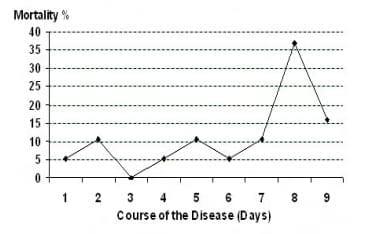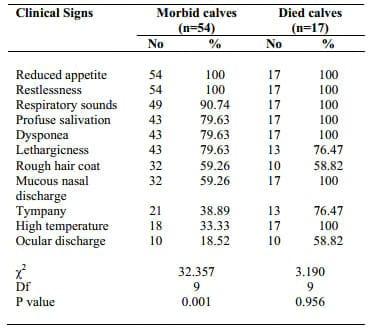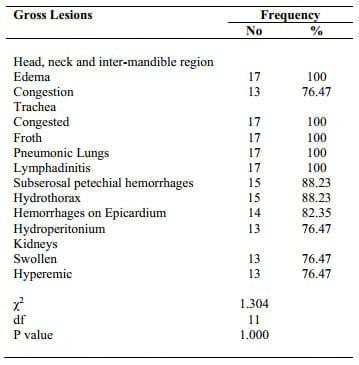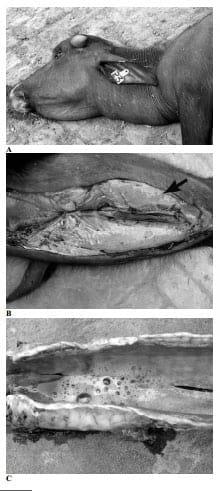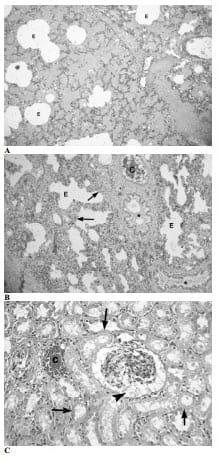INTRODUCTION
Black gold, the buffalo (Bubalus bubalis) is known as the world’s second most important milch animal as it shares more than 95% of the milk produced in the South Asia (Javaid et al., 2009). There are about 29.9 million heads of buffaloes in Pakistan (Afzal, 2010); out of these, 76.7% belong to Nili-Ravi breed, which is the most popular of buffaloes in Pakistan (Khaliq and Rahman, 2010).
Calves play an important role in the development of the dairy sector, as the future of the dairy herd depends upon the successful raising of young calves. Female calves are especially kept for herd replacement. The male calves are usually kept up to weaning (Ahmad et al., 2009). Calf-care is not only essential for sustenance of the dairy industry but is also essential for preserving and maintaining good quality germ plasm, however, some of diseases such as hemorrhagic septicemia, foot and mouth disease and brucellosis threaten health very badly in Pakistan. There is dire need to launch national program for the control and eradication of such frequently prevalent diseases (Afzal, 2009).
Hemorrhagic septicemia (HS) is an acute and often fatal disease primarily occurring in water buffaloes and cattle, but occasionally other domesticated and wild mammals (De Alwis, 1992). Buffaloes are more susceptible to HS than cattle (De Alwis, 1999). Hemorrhagic septicemia is caused by the gram-negative bacterium Pasteurella multocida (Wijewardana, 1992; Tabatabaei et al., 2007). So far, various serotypes (A, B, C, D and E) of P. multocida have been detected among the livestock population (Ghandrasekaran et al., 1981; Borkowska-Opacka and Kedrack, 2003; Kedrak and Borkowska-Opacka, 2003; Kumar et al., 2004). Serotypes B: 2 and E: 2 are two common serotypes of P. multocida associated with disease in animals in Asia and Africa, respectively (Benkirane and De Alwis, 2002). The disease has a major impact on the livestock industry in countries of South and Southeast Asia, where HS associated with serotype B: 2 is distributed widely (Dagleish et al., 2007; Hajikolaei et al., 2008; Ataei et al., 2009). It results in severe economic losses and is ranked as the most important contagious disease of cattle and buffaloes (Benkirane and De Alwis, 2002), with young animals being most at risk of successive outbreaks (De Alwis and Sumanadasa, 1982).
Importance of HS to buffalo rearing in Pakistan is highlighted by a recent survey which indicated its prevalence up to 49% (Farooq et al., 2007). Pakistan, being a sub-tropical region of South Asia has an early summer dry hot environment temperature and late summer is hot and humid, such conditions favor the explosive occurrence of HS (De Alwis, 1999). This manuscript deals with such an outbreak which took place at a farm in buffalo calves.
MATERIALS AND METHODS
Study area
Faisalabad, third largest city of Pakistan is situated at latitude 31° – 26' N, longitude 73° – 06' E and altitude 184.4m. It has long summer episode that extends from May to September. In summer, ambient temperature ranges from 30 to 45°C and even sometimes may go to 48°C. A severe hot and humid (humidity 45.38±13.11%) period begins from mid July and extended up to mid September (Fiaz et al., 2010).
Case history and treatment
At Livestock Experiment Station, University of Agriculture, Faisalabad, an urea feeding trial started in June 2009 on 54 buffalo calves with an average age 6-11 months. These calves were kept on 75% Vanda (concentrate diet) and 25% wheat straw treated with 4% urea. Overall dry ration was having 16% protein contents. Each calf was vaccinated with NIAB (Nuclear Institute for Agriculture and Biology, Faisalabad, Pakistan) HS oil based vaccine @ 2 ml subcutaneous in mid June 2009. In August and September, 2009, weather became harsh with environmental temperature (28-45°C) and humidity 65.8%. Suddenly in September, all the calves became ill (morbidity 100%) and started showing signs of hemorrhagic septicemia. The morbid calves were treated with injections of Triox (Amoxicillin LA 150 mg/ml; Orient Animal Health, Karachi, Pakistan), Excenel (Ceftiofur Sodium – 50 mg/ml; Pfizer Inc, Pakistan), Predicort (Prednisolone Acetate 7.5mg/ml + Dexamethasone sodium phosphate 2.5 mg/ml; S J & G Fazal Ellahi Sons, Lahore, Pakistan) and Vetafenic (Meloxicam 7.5 mg/ml; Diclofenac sodium; S J & G Fazal Ellahi Sons, Lahore, Pakistan) for three days.
Gross pathology and histopathology
When mortality started it was thought that it is due to urea toxicity. Determination of serum urea concentration of morbid animals revealed that it is within normal range. Moreover, lesions were also not supportive of urea toxicity.
All the dead animals were subjected to postmortem examination. Morbid tissues were collected, preserved in 10% neutral buffered formalin and processed for histopathological studies using routine method of paraffin embedding. Sections of 5 µm thickness were stained with hematoxylin and eosin for microscopic study.
Data analysis
For analysis purpose, calves were divided in three age groups, i.e., 6-7, 8-9 and above 9 months. Data thus collected on various clinical signs in relation to morbidity and mortality, mortality in relation to age and postmortem lesions were subjected to Chi square analysis.
RESULTS
Clinical signs, morbidity and mortality
All the calves became morbid (100%) and started showing signs of hemorrhagic septicemia. Out of 54 buffalo calves, 17 died (31.48%). Of the dead calves, more calves (47.05%) belonged to 8-9 months followed by above nine months (29.41%) and 6-7 months (23.53%) (χ2 = 1.111; P= 0.574). Course of the disease spread over nearly ten days. Mortality significantly peaked at 8 th day where it was 37% (Fig. 1).
Fig. 1. Mortality of buffalo calves during the course of hemorrhagic septicemia.
Frequency of clinical signs in morbid animals varied significantly (χ2 =32.357; P=0.001), however, when these clinical lesions analyzed in calves those died later showed non-significant variation (χ2 =3.190; P=0.956). Elevated body temperature (40.63±0.70°C) in 18/54 (33.3%) calves whereas moderately (38.61±0.50°C) and slightly (37.85±1.75°C) raised body temperature was recorded in 22 (40.74%) and 14 (25.92%) affected buffalo calves. Affected calves showed variable clinical signs. All the calves were off feed, depressed and showing restlessness. Respiratory sounds “rales” were present in 90.74% calves. Other clinical signs included were profuse salivation, dyspnea, mucoid nasal discharge, tympany, etc. Respiratory sounds, dyspnea, mucous nasal discharge, high temperature, reduced appetite, restlessness, profuse salivation were present in 100% calves those died of HS (Table I).
Table I.- Clinical signs observed in morbid and died buffalo calves due to hemorrhagic septicemia.
Gross and histopathology
At necropsy, edema of head, neck and intermandible region, congested trachea having froth, swollen, congested and consolidated lungs exhibiting picture of bronchopneumonia and lymphadenitis were present in all carcasses of calves died of HS (Table II). Grossly head, neck and intermandible region were congested and swollen/ edematous (Fig. 2A). This odematous swelling consisted of a coagulated serofibrinous mass (Fig. 2B). Subserosal petechial hemorrhages were present throughout the body. Thoracic and abdominal cavities contained blood–tinged fluid. Scattered petechial hemorrhages were visible in the tissues and lymph nodes, particularly in the pharyngeal and cervical lymph nodes. These nodes were swollen and hemorrhagic. Trachea was congested and contained froth (Fig. 2C). Kidneys were swollen and hyperemic. Liver seemed to be normal. There were petechial hemorrhages on the epicardium.
Table II.- Frequency of gross lesions observed in buffalo calves died of to hemorrhagic septicemia.
Histopathological examination revealed extensive edema fluid accumulation in alveoli along with emphysema (Fig. 3A). Thickened alveolar septa, congestion and edema fluid in bronchioles were also observed (Fig. 3B). Mononuclear cells were infiltrating in the lung tissue and blood vessels contained rod shaped bacteria. Kidneys showed variable degrees of degeneration. Glomeruli were atrophied and nearly all the renal tubules were studded with casts. Tubular epithelium showed pyknosis, condensation of nuclei and necrosis (Fig. 3C). Congestion was also obvious.
Fig. 2. Buffalo calf died of hemorrhagic septicemia showing mandibular and neck region edema and redness. Note the coagulated serofibrinous mass having straw–colored fluid (arrow) in B and congested trachea of buffalo calf containing froth in C.
Fig. 3. Histological structure of lungs of buffalo calf which died of hemorrhagic septicemia showing A) fluid filled alveoli (edema) and emphysema (E), B) exudate in bronchioles (*), thickened alveolar septa (arrows), congestion (C), edema, hemorrhages and emphysema (E), and C) atrophied glomerulous (arrow head), congestion (C), necrosis of tubular epithelium (arrows) and cast deposition in tubular lumens. Stain: H and E. Magnification: A and B 100X; C, 400X.
DISCUSSION
Outbreaks of HS usually occur as catastrophic epizootics in many Asian and African countries resulting in high mortality and morbidity (Bain et al., 1982; De Alwis, 1992). Outbreaks of HS has been recorded in Sri Lanka (De Alwis and Vipulasiri, 1980), Zimbabwe (Lane et al., 1992), South Asia, Middle East and Africa (FAO, 1989), Pakistan (Khan et al., 2006; Farooq et al., 2007). A wide range of mortality rate (5 to 90%) has been reported in different outbreaks in India (Saini et al., 1991) and Philippines (Molina et al., 1994). In the present study, 100% morbidity and 31.48% mortality due to HS has been recorded in buffalo calves. In cattle and buffaloes, morbidity and mortality due to HS has been recorded to be 95.25 and 21.19%, respectively (Khan et al., 2006). This high mortality could be attributed to its acute and sometimes per acute clinical nature which does not allow treating the animals.
HS is an acute, fatal, septicemic major disease of cattle and buffaloes (Farooq et al., 2007) caused by the gram-negative bacterium Pasteurella multocida (Tabatabaei et al., 2007). Serotypes B: 2 and E: 2 are two common serotypes of P. multocida associated with disease in animals in Asia and Africa, respectively (Benkirane and De Alwis, 2002). The disease has a major impact on the livestock industry in countries of South and Southeast Asia, where it causes severe economic losses and is ranked as the most important contagious disease of cattle and buffaloes (Benkirane and De Alwis, 2002).
Major control measure of HS is the vaccination (Benkirane and De Alwis, 2002). In the present study, in spite of vaccination with HS oil based killed vaccine; outbreak of HS took place in buffalo calves. Current vaccines are administered parenterally, require repeated administration, and are not sufficiently efficacious (Tabatabaei et al., 2007). In the present study, there could be vaccine failure or vaccination was not carried out sufficient time before the onset of high-risk season (monsoon) as vaccination of HS for prophylactic purpose must be carried out preferably two to three months before the season (Benkirane and DeAlwis, 2002). It is also recommended that during an outbreak, one should resort to immediate whole herd vaccination, irrespective of previous vaccination history (Benkirane and De Alwis, 2002). This strategy also failed in the present outbreak as mortality reached to 31.48%. A live-attenuated vaccine, which would mimic the early stages of the natural infection, might be expected to confer more solid and longterm protective immunity (Tabatabaei et al., 2007).
Hot and humid weather is a major contributory factor in the outbreak of HS. High environmental temperature (37°C) does favor the growth of the bacteria (Hajikolaei et al., 2008). Weather also posses stress on young calves. Scarcity of green fodder in these days is another stress factor.
HS is a bacterial disease and, theoretically, could be effectively treated by wide range of antibiotics currently available. However, treatment is constrained by a host of practical considerations. According to Benkirane and De Alwis (2002), animals can be cured only if they have been treated in the very early stage of the disease. Under field conditions this is not possible, however, in organized farms early detection and effective treatment is possible. Penicillins are widely used in the treatment of HS because the causative organism is sensitive to this β-lactam antibiotics (Kristinsson and Adam, 2007; Pedersen et al., 2009). In the present study, amoxicillin was used as a major drug for treatment and 68.52% HS morbid calves could be recovered as a result of treatment. P. multocida are resistance to streptomycin, tetracycline, oxacillin and trimethoprim (Wassenaar and Silley, 2008), therefore, while treating HS case such drugs be avoided.
Early treatment depends on the early diagnosis of the disease (De Alwis, 1999). Under field conditions, HS is usually diagnosed on the basis of clinical signs and symptoms (Khan et al., 2006; Farooq et al., 2007; De Alwis, 1999). Most cases of HS in cattle and buffalo are acute or peracute (Anonymous, 2003). It is obvious from the clinical signs recorded in the present study that respiratory sounds, dyspnea, mucous nasal discharge, high temperature, reduced appetite, restlessness profuse salivation were present in 100% calves died of HS (Table I). Such clinical signs with variable degree have already been reported along with distinctive respiratory sound “rales”, and typical swellings in the submandibular region in HS cases (Sheikh et al., 1996; De Alwis, 1999; Farooq et al., 2007).
Pasteurella multocida remains as commensal in bronchi, terminal bronchioles, and alveoli. This pathogen cannot invade lungs due to defense mechanism but stresses as climatic change, malnutrition, transport, etc. trigger the organism and lungs are unable to clear the pathogens (Harper et al., 2006). Organisms are proficient in destructing bovine blood mononuclear leukocytes and lung macrophages. Pharmacologically active substances like histamine, prostaglandins, hyaluronidase, chondroitinase (inflammatory substances) as well as fibro-elastic elements are released with the death of the macrophages (Carter and Chengappa, 1980; Rimler and Rhoades, 1994). Other than release of these active substances, organism leads to septicemia which has the most severe effect in the respiratory tract, heart and gastro-intestinal tract (Radostits et al., 2007). Trachea, part of respiratory is large enough in animals that travels along the neck where acute inflammatory reaction takes place as a result of released inflammatory substances which in return lead to development of submandibular edema (Harper et al., 2006; Shafarin et al., 2009). The changes produced in the lungs comprises of bronchopneumonia which appear as consolidated lungs (Shafarin et al., 2009) that in return produces high bronchial/respiratory sounds (rales). Other than the release of pharmacologically active substances, there is another school of thought in the development and consequences of HS that the Pasteurella multocida produces endotoxins which are responsible for all manifestations (Horadagoda et al., 2001; Zafar et al., 2010). Death of the animals occurs due to hypoxia and toxemia (Khin et al., 2010).
At necropsy, it was observed in the present study that edema in head, neck and inter-mandible region, congested trachea having froth; pneumonic lungs and lymphadenitis were present in all carcasses of calves died of HS (Table II). Such type of lesions has been reported (Sheikh et al., 1996; De Alwis, 1999; Benkirane and De Alwis; 2002; Farooq et al., 2007). HS also leads to fatal peritonitis in calves (Catry et al., 2005).
It can be concluded from this study that HS is highly fatal disease, can provisionally be diagnosis based on a combination of clinical signs, gross pathological lesions and a consideration of hot and humid season. Treatment of the affected cases is only effective when treated at an early stage.
REFERENCES
AFZAL, M., 2009. Improving veterinary service in Pakistan. Pak. Vet. J., 29: 206-210.
AFZAL, M., 2010. Re-designing smallholder dairy production in Pakistan. Pak. Vet. J., 30: 187-190.
AHMAD, S., YAQOOB, M., HASHMI, N., ZAMAN, M.A. AND AMJAD, M.S., 2009. Farmer’s attitude towards interventions regarding buffalo calf health care and management practices under field conditions. Pak. Vet. J., 29: 125-128.
ANONYMOUS, 2003. Hemorrhagic septicemia. Institute for International Cooperation in Animal Biologics. An OIE Collaborating Center, Iowa State University College of Veterinary Medicine. Web: http://www. cfsph.iastate.edu. Accessed on March 22, 2010.
ATAEI, S., BURCHMORE, R., HODGSON, J.C., FINUCANE, A., PARTON, R. AND COOTE, J.G., 2009. Identification of immunogenic proteins associated with protection against haemorrhagic septicaemia after vaccination of calves with a live-attenuated aroA derivative of Pasteurella multocida B:2. Res. Vet. Sci., 87: 207-210.
BAIN, R.V.S., DE ALWIS, M.C.L., CARTER, G.R. AND GUPTA, B.K., 1982. Haemorrhagic septicaemia. FAO Animal Production and Health Paper No. 33, Rome, Italy.
BENKIRANE, A. AND De ALWIS, M.C.L., 2002. Haemorrhagic septicaemia, its significance, prevention and control in Asia. Vet. Med. – Czech., 47: 234–240.
BORKOWSKA-OPACKA, B. AND KEDRACK, A., 2003. Evaluation of immunogenicity of outer membrane proteins of Pasteurella multocida serotype B: 2, 5 in cattle. Bull .Vet. Inst. Pulawy, 47: 374-385.
CARTER, G.R. AND CHENGAPPA, M.M., 1980. Hyaluronidase production by type B Pasteurella multocida from cases of hemorrhagic septicemia. J. clin. Microbiol., 11: 94–96.
CATRY, B., CHIERS, K., SCHWARZ, S., KEHRENBERG, C., DeCOSTERE, A. AND De KRUIF, A., 2005. Fatal peritonitis caused by Pasteurella multocida capsular type F in calves. J. clin. Microbiol., 43: 1480–1483.
DAGLEISH, M.P., HODGSON, J.C., ATAEI, S., FINUCANE, A., FINLAYSON, J., SALES, J., PARTON, R. AND COOTE, J.G., 2007. Safety and protective efficacy of intramuscular vaccination with a live aroA derivative of Pasteurella multocida B:2 against experimental hemorrhagic septicemia in calves. Infect. Immun., 75:5837–5844.
De ALWIS, M.C.L. AND SUMANADASA, M.A., 1982. Naturally acquired immunity to hemorrhagic septicemia among cattle and buffalos in Sri-Lanka. Trop. Anim. Hlth. Prod., 14: 27–28. De ALWIS, M.C.L., 1992. Haemorrhagic septicaemia. A general review. Br. Vet. J., 148: 99-112.
De ALWIS, M.C.L., 1999. Haemorrhagic septicaemia. Australian Centre for International Agricultural Research (ACIAR) Monograph No 57, Canberra, Australia, pp: 1-34.
De ALWIS, M.C.L. AND VIPULASIRI, A.A., 1980. A case of haemorrhagic septicaemia in a wild elephant in Srilanka. Ceylon Vet. J., 13: 17-19.
FAO, 1989. FAO-WHO-OJE Animal Health Yearbook. Rome, Italy.
FAROOQ, U., HUSSAIN, M., IRSHAD, H., BADAR, N., MUNIR, R. AND ALI, Q., 2007. Status of haemorrhagic septicaemia based on epidemiology in Pakistan. Pak. Vet. J., 27: 67-72.
FIAZ, M., USMANI, R.H., ABDULLAH, M. AND AHMAD, T., 2010. Evaluation of semen quality of Holstein Friesian and Jersey bulls maintained under subtropical environment. Pak. Vet. J., 30: 75-78.
GHANDRASEKARAN, S., YEAP, P.C. AND CHUINK, B.H., 1981. Biochemical and serological studies of Pasteurella multocida isolated from cattle and buffaloes in Malaysia. Br. Vet. J., 137: 361-367.
HAJIKOLAEI, M.R.H., GHORBANPOUR, M., SEYFIABADSHAPOURI, M.R., RASOOLI, A., MOAZENIJULA, G.R. AND EBRAHIMKHANI, D., 2008. Study on the prevalence of Pasteurella multocida carriers in slaughtered cattle and relationship with their immunity status at Ahvaz abattoir. J. Vet. Res., 63: 25-29.
HARPER, M., BOYCE, J.D. AND ADLER, B., 2006. Pasteurella multocida pathogenesis:125 years after Pasteur. FEMS Microbiol. Lett., 265: 1–10.
HORADAGODA, N.U., HODGSON, J.C., MOON, G.M., WIJEWARDANA, T.G. AND ECKERSALL, P.D., 2001. Role of endotoxin in the pathogenesis of haemorrhagic septicaemia in the buffalo. Microb. Pathogen., 30: 171–178.
JAVAID, S.B., GADAHI, J.A., KHASKELI, M., BHUTTO, M.B., KUMBHER, S. AND PANHWAR, A.H., 2009. Physical and chemical quality of market milk sold at Tandojam, Pakistan. Pak. Vet. J., 29: 27-31.
KHALIQ, T. AND RAHMAN, Z.U., 2010. Haematological studies of Nili-Ravi buffaloes injected with recombinant bovine somatotropin. Pak. Vet. J., 30: 53-57.
KHAN, A., SADDIQUE, U., AHMAD, R., KHAN, H., MOHAMMAD Y. AND ZUBAIR, M., 2006. Serosurveillance of hemorrhagic septicemia in cattle and buffaloes in district Malakand, NWFP. J. Anim. Vet. Adv., 5: 912-915.
KHIN, M.N., ZAMRI-SAAD M. AND NOORDIN, M.M. 2010. Pathological changes in the lungs of calves following intratracheal exposure to Pasteurella multocida B:2. Pertanika J. Trop. Agric. Sci., 33: 113– 117.
KEDRAK, A. AND BORKOWSKA-OPACKA, B., 2003. Immunological response to outer membrane proteins of Pasteurella multocida serotype A: 3 in calves. Bull. Vet. Inst. Pulawy, 47: 387-394.
KRISTINSSON, G. AND ADAM, H.M., 2007. Pasteurella multocida infections. Pediat. Rev., 28: 472-473.
KUMAR, A.A., SHIVACHANDRA, S.B., BISWAS, A.V., SINGH, P., SINGH, V.P. AND SRIVASTAVA, S.K., 2004. Prevalent serotypes of Pasteurella multocida isolated from different animal and avian species in India. Vet. Res. Commun., 28: 657-667.
LANE, E.P., KOCK, N.D., HILL, F.W.G. AND MOHAN, K., 1992. An outbreak of hemorrhagic septicemia (septicemia pasteurellosis) in cattle in Zimbabwe. Trop. Anim. Hlth. Prod., 24: 97-102.
MOLINA, H.A., DELA PENA, E., CAMER, G. AND PADILLA, M.A., 1994. An outbreak of hemorrhagic septicemia among carabaos in Northern Samer. Philippine J. Vet. Med., 31: 27-33.
PEDERSEN, K., HAMMER, A.S., SØRENSEN, C.M. AND HEUER, O.E., 2009. Usage of antimicrobials and occurrence of antimicrobial resistance among bacteria from mink. Vet. Microbiol., 133: 115-122.
RADOSTITS, O.M., GAY, C.C., HINCHCLIFF, K.W. AND CONSTABLE, P.D., 2007. Veterinary medicine: A textbook of the diseases of cattle, horses, sheep, pigs and goats. 10 th Ed. Saunders Ltd, Philadelphia, USA.
RIMLER, R.B. AND RHOADES, K.R., 1994. Hyaluronidase and chondroitinase activity of Pasteurella multocida serotype B:2 involved in hemorrhagic septicaemia. Vet. Rec., 134: 67–68.
SAINI, S.S., SHARMA, D.R., GILL, B.S., KWARTS, M.S., SINGH, J., SHARMA, J.K., DHILLON, S.S. AND RAMNEEK, R., 1991. Re-emergence of hemorrhagic septicemia in Punjab. Indian J. Anim. Sci., 61: 1178- 1180.
SHAFARIN, M.S., ZAMRI-SAAD, M., KHAIRANI, S.B. AND SAHAREE, A.A., 2009. Pathological changes in the respiratory tract of goats infected by Pasteurella multocida B:2. J. comp. Pathol., 140: 194-197.
SHEIKH, M.A., ANZAM M. AND SHAKOORI, A.R., 1996. Observations on hemorrhagic septicemia in Pakistan livestock. J. Vet. Med. B, 43: 293-304.
TABATABAEI, M., MOAZZENI JULA, G.R., JABBARI, A.R. AND ESMAILZADEH, M., 2007. Vaccine efficacy in cattle against hemorrhagic septicemia with live attenuated aroA mutant of Pasteurella multocida B:2 strain. J. Cell Anim. Biol., 1: 62-65.
WASSENAAR, T.M. AND SILLEY, P., 2008. Antimicrobial resistance in zoonotic bacteria: lessons learned from host-specific pathogens. Anim. Hlth. Res. Rev., 9: 177- 186.
WIJEWARDANA, T.G., 1992. Haemorrhagic septicaemia. Rev. Med. Microbiol., 3: 59–63.
ZAFAR, M.A., MUHAMMAD, G., IQBAL, Z. AND RIAZ, M., 2010. Effects of hypertonic saline solution on clinical parameters, serum electrolytes and plasma volume in the treatment of haemorrhagic septicaemia in buffaloes. Pak. Vet. J., 30: 95-99.
